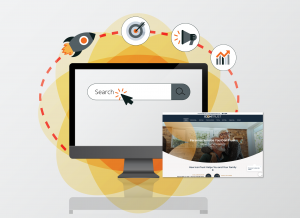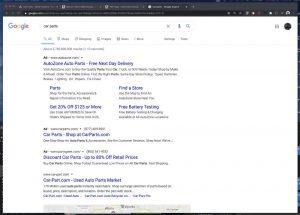Search Engine Optimization – SEO
 SEO is challenging, frustrating, demanding & necessary.
SEO is challenging, frustrating, demanding & necessary.
You should know a few things before hiring an SEO firm. To begin, Google holds all the cards, and changes the “rules” constantly. Search engines are very tight-lipped about how they determine rankings. So, if you suddenly drop in rankings, no search engine will help you in any way as you try to sort out what happened.
Second, most SEO agencies don’t have a clue what they are doing. The vast majority engage in “onsite SEO,” which fine, however, in practice, their approaches are often outdated. SEO isn’t something you do to your website. Your entire digital footprint has an impact on rankings, as do visitor metrics and thousands of signals that indicate to Google and others whether or not their visitors should care about your website content.
You should also be aware that Google structures its search engine results page to maximize paid clicks. Even the idea that page one of the SERP (search engine results page) features 10 websites is largely untrue—especially on mobile devices. Best case, you’re fighting for a place in the top 8, and even then users have to scroll past ads that look almost exactly the same as true organic results.
Search Engine Results Page (SERP) Structure and Layout
Search Engine Optimization isn’t just about the top 10 organic results.

The Google SERP (as of 9/24/20) for desktop browsers will likely display several lines of text ads, a map plus 3 websites featured in the local pack, various featured snippets, a “people also ask” box, a “discover more places” box and a “related searches” box. The top ten organic results will be mixed in with these, which may also include top results for various media like images, video, pdf files, books, etc.
This is far from an exhaustive list. Which SERP features will be displayed depends on the actual keywords being used for the search. Also, the final results are hugely influenced by the searcher’s physical location and many other factors only Google knows about.
For the most part, any of those features that make your website more visible and more attractive to Internet users is good. Most often, we think of SEO as a way to boost rankings, but optimization means increasing your click share as well.
SEO is Slow Motion Marketing
You’ve probably heard many times that SEO takes time. That’s usually true, but it is possible to boost rankings for longer keyword phrases in a matter of weeks. The argument against these “long tail” phrases is much smaller search volumes. However, well-researched long tail phrases almost always convert at a much higher rate.
That said, you should plan your SEO efforts for the long term. The good news is, terms that are slow to rank in search engine rankings are usually slow to un-rank, so they often keep paying off well into the future.
That is, as long as there are no surprises…
Google Updates & Algorithm Changes
Just when you think search engine optimization is easy, they go and change everything.
SEO is a cat and mouse endeavor. Google’s goal is to deliver the most relevant search results for a given query. That way, visitors keep clicking happily away until they click on something Google gets paid for–usually an ad of some sort.
On the other hand, it is up to the SEO pro to ensure that your website is that most relevant result for given search. Google decides based signals. It is up to us to figure out what those ranking signals are.
Good content is always good, but Google constantly changes the rules about every other ranking factor. Backlinks play a major role, but “unnatural” backlinks will get you de-indexed (kicked out of Google) in a heartbeat. Add to that, Google makes changes nonstop. Often, what may have been a standard SEO practice for years, can wipe out millions of website’s rankings with a single update. And there’s no warning system.
Worse, sometimes the update not only impacts rankings by changing the signals, but also includes penalties that you are left to guess even exist.
A lot of what we do involves making sense out of the constantly evolving and unpredictable nature of search engines themselves. We have analytical tools that do little else but work to untangle whatever Google is currently up to.
Onsite SEO is Only ‘Mostly Dead’
A better word might be “misapplied.” Onsite SEO is different today than a lot of ‘experts’ think.
99% of our SEO “competitors” work exclusively onsite… old school. Onsite SEO simply means working within the website itself. In the old school context, “onsite SEO” is managed by manipulating 5 website elements.
- HTML Title, sometimes (wrongly) called the “SEO Title.”
- Meta Description
- Heading Structure & Hierarchy
- Keyword density
- Anchor text, or link text
There are some others, like “alt” text, cross-links, XML sitemaps, meta keywords, etc. Some SEOs are aware of them. Some aren’t.
Of these, the HTML Title and Meta Description are the most important, followed by your XML sitemap. The rest simply no longer make much of an impact. Some, like the keywords meta tag may be a complete waste of time.
However, Schema Markup is ‘onsite SEO’ that is vitally important.
What isn’t a waste of time is Microdata, schema markup and the Open Graph Protocol. These are elements you can control directly within your website. These provide a means to signal to Google exactly what your website, and/or individual web pages, are about. You can include industry details, location information, products, pricing, star ratings and dozens of other elements. These will indicate to Google what “features” we want included on the SERP alongside the usual website links.
Examples of SERP features are star ratings, business hours, pricing, etc.
The important thing is to realize that it takes a lot more than old-school, onsite SEO to achieve top rankings if your market is competitive at all. SEO companies that only focus on traditional onsite SEO elements can’t compete for any but the easiest, least valuable keywords. It’s just that simple.
Domain Name Health
Your website domain name can be sick, and it causes major problems when it is.
Do this now: Open Google in a browser and enter “site:” in the search box, followed by your domain name without any spaces. That’s going to show you all of your pages Google has in its index.
Check to see that your entire website is listed. Each page, or more accurately, each URL (stands for uniform resource locator, in case it ever comes up) will be listed using the page title as a link. Below that will usually be your meta description if there is one.
Doing this will show you whether or not Google is including your entire website in searches. If not, you need to find out why and correct the problem. As mentioned earlier, Google won’t tell you what’s wrong unless a “manual action” has been taken against your website. Indexing problems can be miserable to sort out.
Also, you may discover subdomains or even hacked domains that are being attributed, or included in the index as thought they are part of your website! These can dilute content or worse. It also takes many months to clean up the mess, so let us help you!
If your domain is new to you, there’s a chance it could have previously been used for nefarious purposes or could be blocked from Google’s index entirely. We’re happy to run some tests for you if you think your domain might be toxic.
Many times, we have encountered websites that should be ranking well, but aren’t–in spite of countless hours making adjustments and writing content. A toxic domain will likely never achieve top rankings no matter what you do to correct it.
Backlink Profile
‘Backlinks’ are inbound links from other websites.
It is well known that backlinks, that is inbound links from other websites, are a primary ranking factor Google uses to assess the quality of a website. Backlinks work a bit like votes. The assumption is that a site with a lot of related inbound links it is probably a higher quality website than one with just a few.
In fact, the use of backlinks as a ranking factor was a primary reason Google quickly became the dominant search engine. As a result, web rings and link exchanges became popular as a means of generating links. Today, any tactic Google believes to be “unnatural” will likely get you penalized with increasing severity, depending on what Google believes you did wrong.
Policing your backlink profile is critical, but challenging. We use several custom and 3rd party tools to monitor your backlinks, as well as identify opportunities to build new ones. It’s a fine line. High quality backlinks will provide a significant ranking boost. Toxic backlinks can get you de-indexed—especially if Google believes you’re manipulating your backlink profile.
If you’d like to know what websites have links to yours, drop us a note (jill@ocgcreative.com). We’ll be happy to run some reports and let you know what your backlink profile includes. We won’t even send you a bill.
If we do find a problem, there are tools we can use to mitigate the damage. Cleaning up a a damaging backlink profile takes time, but it is better to know and deal with it, rather than just assume everything’s okay.
Negative SEO Attacks
If this happens to you, it’s a nightmare, but we can help.
Given the weight Google places on backlinks, it has become increasingly common for sites to come under what’s called a negative SEO attack. This is particularly common in very competitive markets with a lot of smart people who happen to be a-holes (please excuse the harsh language, it’s accurate).
Negative SEO attacks come in several forms, but the most popular is for the attacker to build a toxic and unnatural backlink profile for the targeted website. They’ll use an obviously bogus domain name with a shady TLD (top level domain), like .xyz, then build a crappy website (or lots of crappy websites) made up mostly of links to the website they’re attacking.
Usually, the attacker will also buy thousands (or millions) of links from known link farms as well as linking to porn sites and any other “bad neighborhoods.” Hacking is often a feature of negative SEO attacks.
A determined attacker might build thousands of attacking websites, and even use them to spread viruses or execute phishing schemes. Anything that looks bad and points to your website can be damaging.
The problem is so bad that it isn’t unusual for a business to be forced to abandon their domain and start over. It’s infuriating and unfair, but a sad reality in today’s competitive business environment. If you think your website might be under attack, let us know and we’ll glad to check into it for you. If you are under attack, we’ll be able to assess the severity of the attack and help you reverse the damage.
SEO Disaster Recovery
If you’ve read this far, you can see that SEO involves a lot more than keyword stuffing and a few meta tags. Google has the power to determine how we must compete, and frequently makes changes that can be catastrophic.
Most often SEO disasters have leading indicators that go unseen even after the damage has been done.
If you have a website that–no matter what you do–just can’t rise above page 6, or suddenly dropped out of the rankings, we can usually find out what happened and help you recover. It is important to act quickly, since SEO disaster recovery can take many months.
Ongoing SEO Services
Despite the dynamic nature of search engine optimization, for most websites, SEO is a matter of building high quality content and providing the best possible experience for you website visitors.
The process is mostly straightforward, but touches on a lot of factors. Page speed is critical. Healthy backlinks are critical. Indexing frequency is critical. Visitor metrics are critical. Schema markup is critical. Content focus is critical… In other words, everything is critical. Many of these factors begin with intelligently planned web design, by the way.
Effective SEO requires that we keep on top of a lot of things and make constant, incremental gains. SEO companies need to understand and follow rules that not only aren’t published, but frequently change.
As an SEO firm, we’re more affordable and more effective than most. We’re also very generous with our knowledge, so don’t hesitate to reach out even if you just have a few questions.






